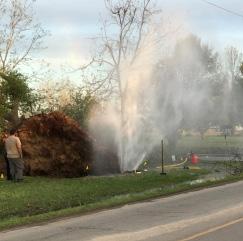The Lore of Odessa – Insight into the MRWA Wastewater System of the Year Gary Webber, MRWA Wastewater Technician more of their situation; what their challenges were and how they were applying themselves, it was inspiring. “They can teach me a lot,” I thought, and I listened and tried to comprehend all they were showcasing.
The battle-weary horsemen rapidly approach to a safe and secured vantage point overlooking the immense body of water. As the horses settle from their heavy breaths a deep enduring voice echoes to their leader “We are here, we have conquered our way to the sea.” A woman dressed for adventure, sitting tall on her enchanted horse, surveys the small town before her. Dark clouds adorn the sky with promising lighted rays shinning here and there, her hair dancing in the wind as she leans forward in her saddle, she lifts her sword. Catherine The Great speaks, “Her name shall be Odessa!” Centuries have passed since that day, but the intriguing name still brings curiosity to one’s spirit. Odessa, the Missouri city, was mentioned to me by a friend who said I should stop by and talk to those working at the city. My friend said, “The operators do a really great job, they are trying to overcome a lot of obstacles, and they may need help with some of their wastewater issues.” It took a while to make that trip, maybe too long, but one afternoon I made a dash for Odessa. I was able to locate one of the city staff members by phone, and we met at the new wastewater treatment plant late in the day. “My name is Randy Johnson,” he said, and boy did that bring back good memories. “You are not the Randy Johnson I knew. Did you know him?” The conversation began from there, we hit it off from the get-go and Mr. Johnson showed me around the treatment facility. Touring the facility was a treat. “What a plant!” I thought, and over time as I got to meet more of the staff and learn
MRWA Drone picture of Odessa’s Northwest Treatment Facility. Picture taken by Joe Anstine.
Odessa has two wastewater treatment facilities; a Northwest Treatment Plant which was put into service in November of 2015 and the Southeast Treatment Plant born in July of 2007. The Northwest Plant is designed for 2 MGD and can deal with peak flows of 4 MGD. It replaced a lagoon system that had become obsolete. The Southeast Plant is designed to accommodate 1 MGD and a peak flow of 2 MGD. Both are oxidation ditch concept-plants with added treatment features such as filters, UV disinfection, and sludge presses. Balancing food-to-microbe ratio is a real challenge at the Northwest Treatment Plant due to its current low-flow. To make this work as well as they do, the operators must be on their toes. Like a lot of other communities in Missouri, Odessa deals with aging infrastructure. Their wastewater collection system is no different than most in that it too has issues with Inflow & Infiltration (I & I). (continued on page 25) 23









